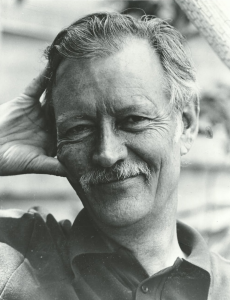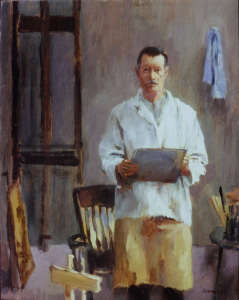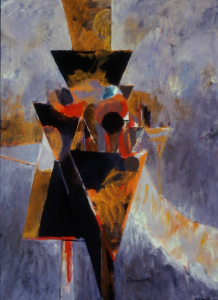

Biography
Bernard Arnest was born in Denver, CO in 1917. He thought he would study music and become a pianist, but he discovered his aptitude for art in a high school drawing class. He attended East High School, where he benefited from having as his teacher the legendary instructor Helen Perry, a mentor for other Denver students who achieved national fame. Arnest received additional instruction from the newly founded Kirkland School of Art and from Frank Mechau's school in Denver. As a senior Arnest won prizes for the best painting in his school and took home the Charles Milton Carter Memorial Prize for the best painting in the city. His work so impressed the reporter for the Rocky Mountain News that he declared the city-wide exhibit a one-man show - in terms of quantity and quality for young Arnest.
Graduating from East High in 1934, Arnest enrolled at the Broadmoor Art Academy (soon to be renamed the Colorado Springs Fine Arts Center), where he studied under Boardman Robinson and Henry Varnum Poor, with additional instruction on the making of murals from Frank Mechau. Arnest attended Broadmoor from 1935-1937 and from 1938-1939.
Arnest studied lithography with guest instructor Charles Locke in 1937. He produced some good work in this area, but it did not become a major area of emphasis for him. He also made several mural studies, one of which was submitted in a competition for the Amarillo, TX Post Office. He did not win that competition but was awarded a commission for the Wellington, TX Post Office, where he completed "Settlers in Collingsworth County" in 1940.
Arnest received a Gugenheim Fellowship for creative work in painting in 1940, which he used to study in San Francisco. This led to a one-man show at the San Francisco Museum of Art (1940).
With World War II on the horizon, Arnest joined the Army Signal Corps in 1941. He served as a war artist in Iceland for nine months in 1943. From there he went to England, after which he was named to a 5-man team attached to the History Section of the U.S. European Theater of Operations (ETO). He served as Chief War Artist for the U.S. Army Historical Section in the ETO from 1944-1945, traveling from England to France, Germany, Belgium and the Netherlands. He covered the Battle of the Bulge, painted the Bridge at Remagen, met with Russian troops at Strela on the Elbe River, and saw first-hand the horrors of Buchenwald. He received a Bronze Star for helping in a rescue mission near a minefield outside of Aachen.
Following the war, Arnest moved to New York, feeling that any artist should spend some time there. He stayed in New York from 1945-1947, making trips to New England and the American South in 1947. While in New York he gained representation by the Kraushaar Galleries, which represented him from 1947-1986.
In 1947 he was named chief instructor at the Minneapolis School of Art, where he worked from 1947-1949. He participated in the Whitney Annual Exhhibition of Contemporary American Painting (1947), the Carnegie International (1948), and the Corcoran Biennial. He married in 1948 and eventually had three children: Mark Arnest, Lisa Mondori, and Paul Arnest. He had his first one-man show at the Kraushaar Galleries in 1948 and another one-man show at the Minneapolis Institute of Arts in 1949.
Arnest was hired at the University of Minnesota in 1949 and held successive positions as instructor, assistant professor and associate professor there from 1949-1957. He exhibited at the Carnegie International in 1952, and, based on his wartime experience, was commissioned to create a three-panel mural for the Veterans Service Building on the grounds of the state capitol in Saint Paul, MN in 1955. He created another mural - this one abstract - for the First National Bank at Southdale Center in Edina, MN.
In 1957 Arnest returned to Colorado to teach at Colorado College in Colorado Springs. He became the head of the Art School and a Professor of Art in 1965 and remained in Colorado Springs until his retirement in 1982.
As recipient of a State Department grant, Arnest was able to travel to Afghanistan in 1960 to paint scenes of that country. He produced 26 paintings based upon his sketches from Afghanistan. They were exhibited at Lehigh University in 1964.
A 1971 trip to Europe revived Arnest's interest in drawing. He had a "Rock 'n' Roll" period where he painted musical gatherings, including rehearsals of his son Mark's band. And in 1975 he poured forth his emotional response to the Nixon Era and the War in Vietnam with his "Scenes from Life," 51 large drawings of a very tragic world. Following Arnest's death in Colorado Springs in 1986, "Scenes from Life" were shown in a retrospective at the Coburn Gallery at Colorado College. They now reside in the collection of the Colorado Springs Fine Arts Center collection.



Critical Analysis
Bernard Arnest's training at Broadmoor had two major points of emphasis. One was speed. Arnest joked that if he saw someone fall out of a third-floor window, he could complete a sketch of the person before he hit the ground. This facility was an obvious asset for Arnest's career as a wartime artist. Of course it wasn't just speed that counted; Arnest also developed into a superb draftsman. The second point of emphasis that Arnest picked up at Broadmoor was the departure from classical forms to focus on everyday subjects, as emphasized by Boardman Robinson. This put Broadmoor students in good stead with the federal government, which prefered paintings of regional topics. Arnest called this "picture-making" - as opposed to painting. And, while he focused on this sort of picture-making throughout the 1930s and 1940s, in the 1950s he tried his hand at more abstract topics - often taking physical objects as a point of departure, but constructing a painter's view of those objects, not a photographer's. He found the experience quite liberating.
Arnest moved back toward more representational art in the 1960s and 1970s. First, his trip to Afghanistan was explicitly grounded in the creation of scenes from that country, which meant he had to make pictures of what he saw. And then, as the wars and scandals of subsequent decades dominated the consciousness of many Americans, he felt a need to express his feelings in fairly explicit terms, which is what led to his drawings for "Scenes from Life." Unfortunately, few examples of this work are available outside of Colorado Springs, but it would appear that these drawings are almost a throwback to the visceral work of Arnest's war years. In any case, after completing "Scenes from Life," Arnest returned to landscapes and other more placid themes.
Murals
- Wellington, Texas - Post Office: Settlers in Collingsworth County
References
- Arnest Fest (Colorado Springs Gazette).
- The Artists (Artists in Uniform).
- The Artwork of Bernard Arnest (The Artwork of Bernard Arnest ).
- Stan Cuba, Artworks That "Captivate the Viewer Quietly", History Colorado July 24 (2019). Article on Bernard Arnest, who, like the Magafan sisters and Edward Chavez, attended Denver East High School and studied under art teacher Helen Perry.
- Bernard Arnest Exhibits at Lehigh University Art Gallery, Francis Quirk Master Painter Blog February 17 (2020).
- Bernard Patrick Arnest (askART).
- Donald J. Bear, High School Art Exhibit Accorded High Praise, Rocky Mountain News Volume 75, Number 154, June 3 (1934).